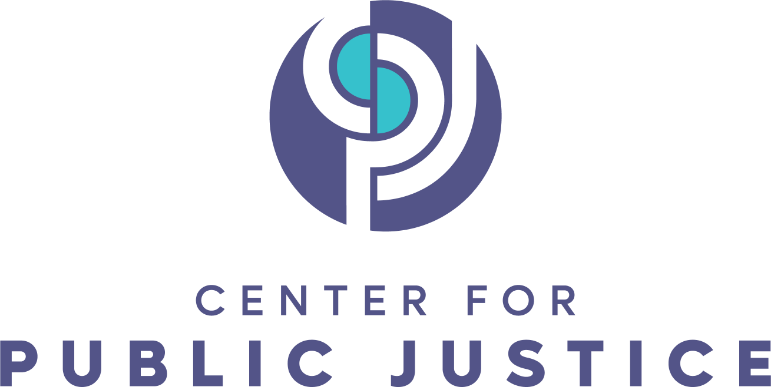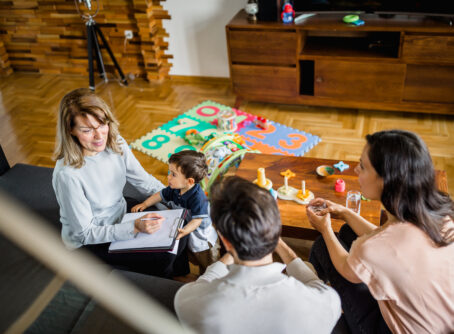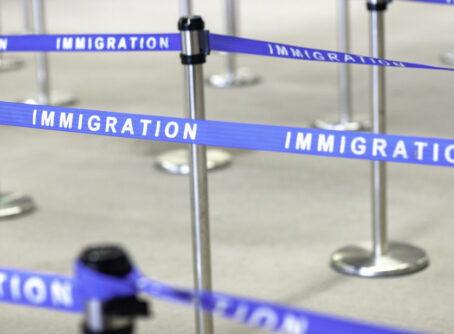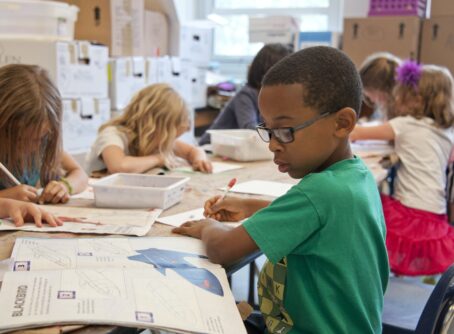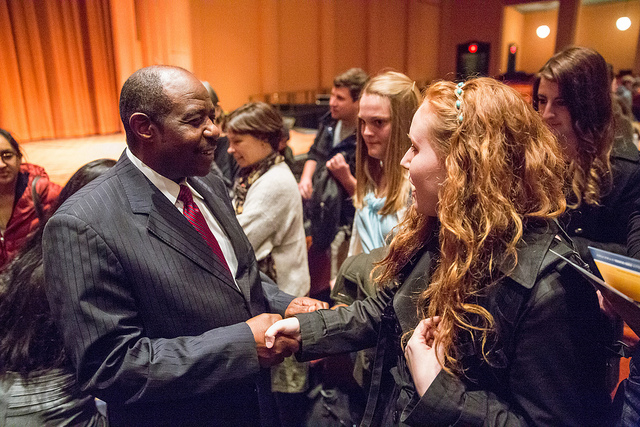
This article is part of the Religious Freedom Reframed series, which is exploring perspectives on religious freedom that have historically been left out of public discourse, as well as implications for individuals, institutions, and society overall. In this series, authors will use a public justice framework to explore narratives that are traditionally left out of the conversation on religious freedom. This series is designed to introduce fresh perspectives, feature new voices, and examine historical and present injustices in the application of religious freedom. The Center for Public Justice, a Christian faith-based organization with a strong commitment to religious freedom, has intentionally invited authors from diverse faith traditions and perspectives on religious freedom to share their insights and experiences of religious freedom in the United States.
Public discourse and imagination concerning religious freedom are inextricably tied to issues of race and ethnicity in America. This is because most white Christians in America hold together an assumption of Christian faith as foundational to the United States and a racialized imagination of our nation—that is, they define American identity by a majority white experience. These beliefs, even when well-intended, render all other ethnicities and religious traditions as foreign or peripheral to the narrative of the United States. In short, Christianity is often imagined as white, Western, and American, whereas traditions like Islam, Buddhism, and Sikhism are non-white, Eastern, and un-American.
In this article, I will argue that religious freedom offers us a vibrant, pluralistic vision where diverse experiences and beliefs not only co-exist, but are equally celebrated and respected. This hopeful imagination of human flourishing and common good is one where stories are shared, neighbors are loved, and pluralism thrives in our nation.
MAKING SENSE OF THE EVANGELICAL LANDSCAPE
Billy Graham’s 1950s nationally syndicated radio broadcast, Hour of Decision, ushered in the golden age of American evangelicalism and fused Christianity to a larger vision of “Americanism.” Graham denounced the secularism of his day and called America to “turn back to God and the Bible.” Borrowing from Charles E. Fuller’s Old Fashioned Revival Hour, every week Graham reminded his listeners of a time when Christianity was the faith of America—when traditional values were accepted and church building was the center of every Mayberry town. This appeal, rooted in a sense of nostalgia for a long-lost past, was attractive to a specific group of Americans who looked fondly on prior centuries of North American history. However, as the tensions of the Cold War grew, Graham’s broadcasts provided little comfort for non-white Christians and religious minorities who, in the era Graham so fervently appealed to, were oppressed, persecuted, and enslaved.
This evangelical tendency to unite faith and nation helps us make sense of white evangelical engagement with religious freedom today. As America grows ethnically diverse and religiously plural, the majority white evangelicals move between two responses.
One response is rooted in a nationalist understanding of America as ‘God’s chosen nation’ and rejects religious freedom as an unbiblical, secular ideology. Espoused by evangelicals like John MacArthur, those who respond to religious freedom in this way view Christianity in America as being “under a massive assault.” These evangelicals see religious pluralism as a path to idolatry and “the kingdom of darkness.” In an article reflecting on MacArthur’s view of religious pluralism, Russell Moore recounts a similar experience of a pastor arguing that religious freedom is “essentially the affirmation of the words of the Serpent, ‘Ye shall not surely die’ (Gen. 3:4).” Moore continues, “to grant religious freedom for false religions, this person contended, is the equivalent of allowing the prophets of Baal have a place of their own on Mount Carmel.”
Another evangelical response to these trends accommodates religious freedom insomuch as it protects evangelical self-interests. In his book Liberty For All, which discusses “how Christians ought to understand religious liberty”, evangelical professor Andrew T. Walker elaborates that “religious liberty is not about…treating all religions as equals…Religious liberty is about giving individuals space to figure out for themselves who God is.” Pluralism, for Walker, is a consequence of a fallen world. Therefore, “the Gospel goes forth by persuasion, as individuals hear and respond (or not) to the news of God’s arriving kingdom.” Through this logic, Walker arrives at the need for religious freedom.
Again, evangelicals often shift between these two responses. Even John McArthur, who fervently opposes religious freedom, appealed to his constitutional right for religious freedom in a two-year battle with the state of California over the ability of his church to meet in spite of COVID-19 regulations. This tells us that, for many white evangelicals, religious freedom is self-serving, rather than for the good of our neighbors.
RELIGIOUS FREEDOM AND RELIGIOUS MINORITIES
Observing my evangelical peers and their responses above, I believe both responses present a fundamentally limited and theologically unsound imagination of religious freedom. Diagnosing these understandings of religious freedom as problematic requires a deeper understanding of a correlation between religious freedom and the experience of religious minorities.
In a society where hijabs are torn, turbans are markers of terrorism, synagogues are protested and mosques are burned, and the Islamophobia industry profits from fostering hostility towards religious minorities, we must understand how, for many marginalized communities and minority faith traditions, religious freedom is a means of survival and protection.
A greater picture of religious freedom requires a robust understanding of the ethnic, cultural, and religious minority experiences. Only after these stories and experiences are included in our understanding of American society and our vision for human flourishing can we develop a robust understanding of religious freedom and “liberty for all.”
ASIAN AMERICANS AS A CASE STUDY
Asian American communities provide an excellent case study. Enveloped in myths of model minority assimilation and perpetual foreignness, Asian American communities have historically been subject to efforts of religious and racial discrimination. Indeed, Asian American bodies, as well as the churches, temples, gurdwaras, and mosques they worship within, continue to be targets of terrorism, violence, and anti-Asian legislation. Imagined as particularly foreign and non-American, Asians are often conflated with fictional and racialized portrayals of terrorism, radicalism, and violence.
From the Chinese Exclusion Act of 1882 to President Roosevelt’s “Executive Order 9066” which called for the forced removal of Japanese immigrants and their children who were US citizens, the presence of Asian Americans has always presented a threat to majority-culture understandings of religion and race in America. For example, in 1911 the United States Immigration Commission publicly stated that “East Indians” were the “least desirable race of immigrants admitted in the United States” and predicted that because of their tropical native country, they would be a “burden upon the communities to which they go.” Also, following the bombing of Pearl Harbor, Japanese Americans were marked by fearmongering rhetoric of a “Yellow Peril” and labels of “heathens” and perceived as a threat to national security.
Racialized tropes and assumptions about Asian Americans are not a tale of the past. Today, anti-Asian sentiment has continued to influence American politics. For example, President Trump’s 2017 Executive Order 13769, commonly known as the “Muslim Ban,” placed harsh restrictions on travel to the United States for citizens of Iran, Iraq, Libya, Somalia, Sudan, Syria, and Yemen. The COVID-19 pandemic also reinvigorated these prejudices and biases at a public level. Anti-Asian hate crimes, primarily against Asian elders and religious communities, rose almost 150 percent in America’s largest cities.
Just two decades after Roosevelt’s executive order, the Immigration Act of 1965 was passed, ushering in millions of Asian immigrants of faith into America. Between 1986 and 2012, China, India, and Vietnam accounted for three of the top five immigrant-sending countries to the United States as the population of Muslims, Hindus, Buddhists, and Sikhs reached record highs. Steven Waldman notes that during this period, Hindu priests and Muslim Imams were invited to the White House to lead national prayers and celebrate religious holidays for the first time in American history. In the past decade, international student visas from Asian countries have also significantly increased. In 2012, about 55 percent of all international students came from China, India, South Korea, and Saudi Arabia, where the dominant religions are Buddhism, Hinduism, Confucianism, and Islam. Post-1965, as religious pluralism flourished, Asian communities did as well.
In response to current anti-Asian hate crimes revolving around COVID-19, religious Asian American communities have asserted their rightful place in American civic life. Projects like Virulent Hate and Stop AAPI Hate work across religious traditions to collect stories and accurate data, organize local communities, and elevate the voices of those who live on the hyphen between Asian and American. These are examples of enacted religious freedom—the Word made flesh in the embodied actions and activism of individuals and the body of Christ advancing civic love of neighbor.
The story of Asian America is not merely one of internment and oppression, but of liberation and self-giving. In the face of discrimination, marginalization, and confinement, Asian-Americans of diverse faith traditions have sought to broaden America’s conception of religious freedom by insisting they could be both Asian and American.
FROM MELTING POT TO POTLUCK
In this greater picture of religious liberty, we must not mistake America for a melting-pot that promotes culture-erasing assimilation into America’s majority-white experience. Rather, as Eboo Patel illustrates in his book Out of Many Faiths, we might view the religious and ethnic landscape of America as a potluck — a gathering of peoples and cultures with an open invitation to come in the fullness of one’s ethnic and religious identity. At this potluck, we are given opportunities to taste and experience the perspective of another, devoid of any desire to colonize or appropriate.
Patel’s imagery of a great, multicultural potluck is deeply empathic. It calls us into relational and experiential knowledge, leading us to an awareness of the differences around us. In moving towards and working alongside communities different from our own, we cultivate a deep sense of humility. The names, stories, and struggles of marginalized communities and tribes tear down tribal imaginations and affirm that a plurality of faiths and cultures are embedded into the composition of American identity. Further, stories from the margins foster new ways of imagining so that words like “Islam” or “Asian” do not bring to mind a faceless “other”, but rather remind us of our neighbors and our friends.
Through the transformation of our communities, congregations and tribes, the values of the potluck can move from local gatherings to the institutions that guide much of American life. Through this institutional change, we may put aside representative identity politics and move towards meaningful change where religious freedom may be accomplished in its fullness.
As a Christian, I believe that religious freedom, like the ministry of Jesus, should be animated by sacrifice. We are called to advocate for the freedoms and rights of our neighbors and the institutions of which they are a part because they are our neighbors, equally bestowed with the image of God. We are also called to, as Christians in America, lay down our power and priority and give meaningful decision-making, culture-shaping power to religious minorities. Cooperation across these lines of difference serves as a bulwark against the polarizing and divisive powers of our world today. It rejects the tribal binaries of our world and instead calls us together towards the flourishing of all people and the public good.
Amar D. Peterman (M.Div., Princeton Seminary) is an Indian American writer, speaker, and emerging public theologian. His writing and research appears regularly in Sojourners Magazine and the Christian Century and have also been featured in Christianity Today, the Berkley Center Forum, Faithfully Magazine, the Anxious Bench, and more. His first book, Empathy: Loving Well in a Divided World, is under contract with Eerdmans Publishing. You can follow him on Twitter: @amarpeterman
